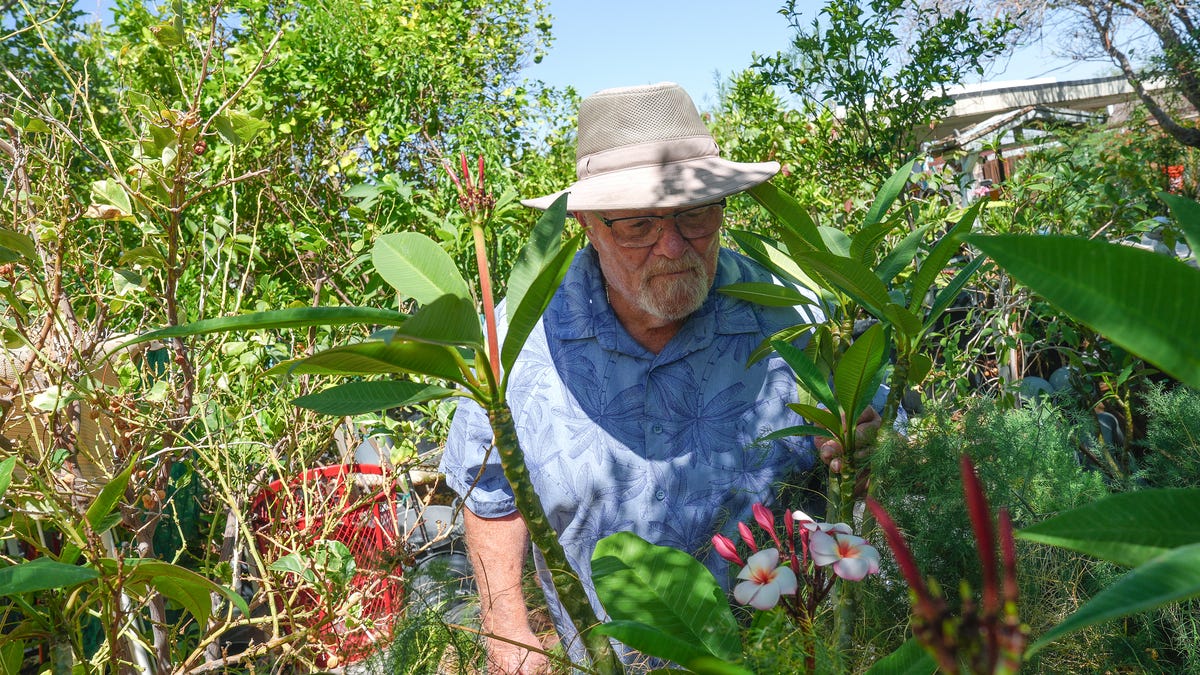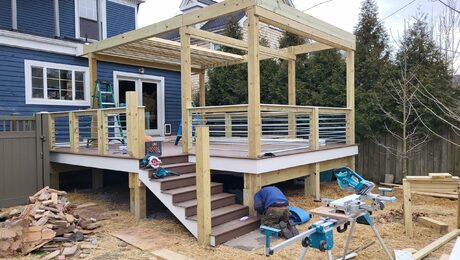Follow the Fine Homebuilding Podcast on your favorite app. Subscribe now and don’t miss an episode:
Mike shows his shade structure. Anne figured out a way to explain air-sealing. Chris has thoughts on the HVAC industry. John asks about rebuilding his porch railing. Mike is looking for watertight porch flooring. Brett is recreating Japanese stone footings. Eric is considering a mid-life career change to construction work.
Editor Updates:
_______________________________________________________________________
Listener Feedback 1:
Mike from Pittsburgh writes:
Hey Patrick & Crew,
I was listening to the podcast today and I wanted to comment on Brian’s plans for a shade structure and the crew’s suggested methods for installing slanted rafters to better block the sun. As it happens, I’m currently building just such a structure. (For Patrick’s reference, it’s in Sewickley.) My initial thought was to build it as suggested—end-screw each rafter into the beams. However, my engineer quickly nixed this plan and pointed out that such structures are indeed covered by the building code and must be built to support standard roof loads. His solution was to add blocking between each rafter cut at the required angle specified by the architect based on the sun’s angle over the site. I also added a ledger fastened to the beam below the rafters to add additional support and to keep the rafters in line during installation. The blocking is cut from 2x4s on a miter saw set at the correct angle. It’s quick and easy to make and speeds the installation and spacing of the rafters. This structure is just over 12 ft. wide, so additional blocking was added down the center of the joists. I screwed a 2×4 under the center blocking the full length of the deck just to make the blocking a bit cleaner when viewed from below. I’m enclosing a couple of in-progress pictures for your reference.
Incidentally, the engineer also required the 2×6 beams connecting the posts side-to-side as shown in the picture. Personally, I think this was overkill since the 50 or so rafters would certainly serve the same function, but I couldn’t talk him out of it. So I covered the top of each pair of them with an Azek 2×10 and installed LED strip lighting inside.
Hope this helps,
Mike
 |
RELATED STORIES
_________________________________________________________________________________
Listener Feedback 2:
Anne from New Hampshire writes:
Hello to my favorite podcast hosts!
I am a mere homeowner who has struggled for many long hours air-sealing only to hear my 84-year-old mother tell me that buildings need to breathe. During one of these building science discussions with my mother, I thought of a metaphor to help convey the concept: a house full of holes is like attempting to breathe with a collapsed lung. Once the house is all sealed up, then it can purposefully take in fresh outdoor air and expel stale air, also known as breathing. If the house is full of holes, it has just become a big air filter gasping for every breath and unable to maintain pressure.
I hope you enjoy my metaphor today! I have a question for you as well!
I’m in the process of having a 1962 Cape renovated, insulated, and air-sealed. The insulation contractor said that he is hoping to get to 1.5 ACH50 and that I will need either an HRV or ERV…I think it’s the ERV. The house is in central New Hampshire, which I believe is zone 6…so cold! This sounds great, but I find myself on the brink of puzzling new questions like the ones below.
Will I need makeup air in order to run a kitchen vent or bathroom fan? How about having a fire in the giant fireplace in the middle of the house? I would like to be able to do all of the above. Also, will I need a central dehumidifier? How do all these interact with the existing oil-fired, forced-air heating system? At some point, I would like to add a heat pump to the system in order to add air-conditioning to the house. How do I plan for all this? Is there a building science decision tree out there to help confused homeowners?
Thank you so much!
Anne
RELATED STORIES
_________________________________________________________________________
Listener Feedback 3:
Chris from Chicago writes:
Greetings again FHB crew,
Wow, what a great episode! You touched on two of my favorite topics: the HVAC industry and dehumidification. I think there are several problems in the industry that are more acute in the residential market than commercial.
For starters, I think many technicians view it at as a job and not a career or profession. That applies to almost every field. If you view it as a job, you probably are not gonna have the drive or interest to learn more than you need to know to collect a paycheck. Most people just want to learn enough to do their job at a basic level. How many are really good and at the top of there profession? 10%? Maybe.
I think at FHB you are encountering those at the top of their field. Sadly, I don’t believe they represent the majority. Also, let’s face it, employers usually don’t want to spend the time or money to train people well. They are afraid employees will just jump ship and go work somewhere else.
Keep the great shows coming,
Chris
RELATED STORIES
_________________________________________________________________________________
Question 1: What type of wood should I use for porch repairs/replacements?
John from western New York asks:
I’m looking for some advice on a porch rehab. Some of my porch flooring and all of the handrails and balusters need to be replaced. Also, some posts have rot at the bottom and need to be “mended.” My carpenter fixed the worst post last year by cutting it at a detail line, inserting a 4×4, then boxing out the bottom with 1x material. That worked well, so I’m pretty sure we have that part figured out.
For the damaged deck/flooring, why is fir the only recommended wood from my carpenter and lumberyard? Why is sapele the only recommended wood for the railings and balusters? It seems to me the harder sapele would be better for flooring and the lighter fir would be better for the railings. Also, why is white oak not in the running? The price of white oak seems on par with sapele. We were planning on getting rough 8/4 material, then milling it ourselves for the handrails and balusters. The house was built in 1900 in western New York. There is a gingerbread trim along the top of the porch that I would like to match, so keeping the same design would be preferable.
Love the podcast,
John
Related Stories
_________________________________________________________________________________
Question 2: How do I make a porch floor watertight?
Mike from Pittsburgh writes:
If you want a question to puzzle on, this same house (see Listener Feedback 1 above0 has a nice front porch with Douglas-fir flooring. The problem is that it’s starting to fail, and for some reason there are semi-finished basement rooms under it. They want to replace the flooring and at the same time stop the “rainfall” in the basement rooms. Any ideas on how to replace the floor with wood and make it watertight? I thought of EPDM under the floor but I’m sure that would only lead to rapid rotting.
Mike; Pittsburgh, PA
Related Stories
_________________________________________________________________________________
Question 3: Will Japanese stone footings survive frost heave?
Brett from Philadelphia writes:
Hi FHB Podcast,
I’ve recently completed a barn renovation and would like to do a traditional timber-frame shed roof and freestanding deck. I already attached the ledger for the rafters when I did the siding. For the footings that will support the vertical posts for the roof and deck, I’d like to do traditional Japanese stone footings. My question is: how do these footings work? Japan gets snow, so I presume they have some frost line, yet these footings are very shallow. Do the vertical stones and gravel infill absorb the frost heave somehow? I’m trying to avoid deep excavation for footings, and I love the traditional scribed-to-stone look. Please advise as to whether this is lunacy to attempt.
Here are some resources I’ve collected:
Thanks,
Brett
Related Stories
________________________________________________________________________________
Question 4: Is now a good time to start a career in the building industry?
Eric from Boston writes:
Hi Patrick and team,
I wrote in a while back about the tilt/turn windows on my 1789 antique Cape that I started renovating in 2021. Tuning into the podcast is the high point of my week, so thanks for the time and effort you all put into producing it! The reason I’m writing again is that I’m thinking about shifting my career to be involved in the building industry, which—as a 53-year-old—may seem a bit odd, but I thought it would be interesting to open the question up to the podcast team for some professional advice as well.
I now work as a graphic/web designer, but I previously worked professionally as a house painter in my late 20s and on my own home on tons of projects over the last 25 years, taking on more complex projects as my skills increased and always looking forward learning new ones. FHB and its resources have helped me tackle larger and larger projects and keep up with techniques, materials, and best practices. Thanks for enabling my creative tendencies!
Some of the projects I’ve worked on include: making energy-efficiency improvements in my home; doing all of the demo before a major renovation; renting a trench digger for the install of a new gas line; building a new portico over a front entrance; designing and building a 15×25 cable-railing deck with locally rough-milled black locust decking that needed to be ripped, planed, and finished and ended up taking me three times as long as I thought it would; refinishing and installing reclaimed wide-plank floor boards that I salvaged from our 18th-century house before the renovation; trimming out and installing reclaimed flooring on new stairs; building a kitchen island with reclaimed materials; tiling two bathrooms; and more. I particularly enjoy repurposing reclaimed wood, and my wife now refers to me as the wood whisperer.
About 10 years ago, I went to grad school for sustainable design/greenbuilding technology, but didn’t transition into that type of work at the time. What would you recommend to someone who likes to work with his hands and is passionate about the craft of building smarter in a lower-carbon manner who is considering working in the industry? Am I completely nuts? I just want to work within a community of like-minded people on cool projects!
The last time I considered a course correction in my career was during the economic downturn of 2008, and getting into the industry at that time wasn’t an option due to a lack of projects to work on. My timing wasn’t great then, but perhaps this time it would be better? The thought of striking out on my own and getting licensed as a GC seems a bit daunting without a business partner as well.
Again, I really appreciate your guidance and ideas, and please feel free to put this question on the podcast if you deem it relevant to the audience.
Best,
Eric
Related Stories
Represent your favorite podcast! Available in several styles and colors. Made from 100% cotton. Find the Podcast t-shirt and more cool products in the Fine Homebuilding Store.
The show is driven by our listeners, so please subscribe and rate us on iTunes or Google Play, and if you have any questions you would like us to dig into for a future show, shoot an email our way: [email protected]. Also, be sure to follow Fine Homebuilding on Instagram, and “like” us on Facebook. Note that you can watch the show above, or on YouTube at the Fine Homebuilding YouTube Channel.










